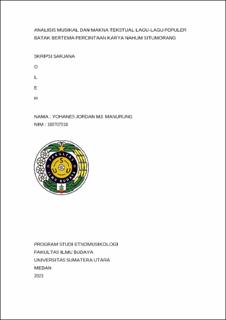| dc.description.abstract | The theme of romance in the song Nahum Situmorang has become one of the themes most in demand by the public to date. This research aims to analyze the textual meaning in songs with a love theme by Nahum Situmorang and concept/theory proposed by Prier to analyse the musical structure. The theory used in this research is the semiotic theory proposed by Roland Barthes to understand the meaning of text through aspects of the connotation and denotation meaning of song texts. The research method used is qualitative research which produces descriptive data in the form of words. Data collection was carried out through literature studies and field work, and data analysis was carried out through working laboratories. The results of the research show that the textual meaning in songs with a love theme by Nahum Situmorang, based on semiotic analysis of the lyrics of the songs "Ala Dao", "Na Sonang Do Hita Na Dua", and "Sai Gabe Ma Ho", reveals various meanings of love in love relationship. The lyrics of the three songs teach honesty, openness, and communication as important aspects in maintaining the integrity of love. Love is felt by two hearts that are always together, giving a sense of security, comfort, and trust. In a relationship, love also requires sensitivity, caring, meetings, and honesty with each other. Communication is key in building strong relationships, strengthening love, and facing challenges together. The musical structure in love theme songs by Nahum Situmorang uses scales in order from lowest to highest, with the basic notes F and C. The song "Ala Dao" uses the Bes note most often and Es as the note used least often. The song “Sai Gabe Maho” uses the note C most often and F as the note it uses the least. The song "Nasonang Do Hita Nadua" uses the tone E with the tone Fis as the tone that is rarely used. The most dominant interval in the song "Ala Dao" is Prime Pure (1P) with a total of 154, while the song "Sai Gabe Maho" has a Prime Perfect (1P) interval of 59, and the song "Nasonang Do Hita Nadua" has a Secondary Major interval (2M ) as many as 53. The three songs have a pattern of verse forms (A) and (B) which repeat in the pattern A - B - A - B, with section B as the song's conclusion. The contour of the song "Ala Dao" is static and descending, "Sai Gabe Maho" is static, and "Nasonang Do Hita Nadua" is pendulous. The tempo of the songs “Ala Dao” and “Sai Gabe Maho” is 112 bpm, while “Nasonang Do Hita Nadua” is 68 bpm. The singing duration of the song “Ala Dao” is 2 minutes 04 seconds, “Sai Gabe Maho” is 2 minutes 12 seconds, and “Nasonang Do Hita Nadua” is 2 minutes 09 seconds. All three songs have a 4/4 meter. | en_US |




